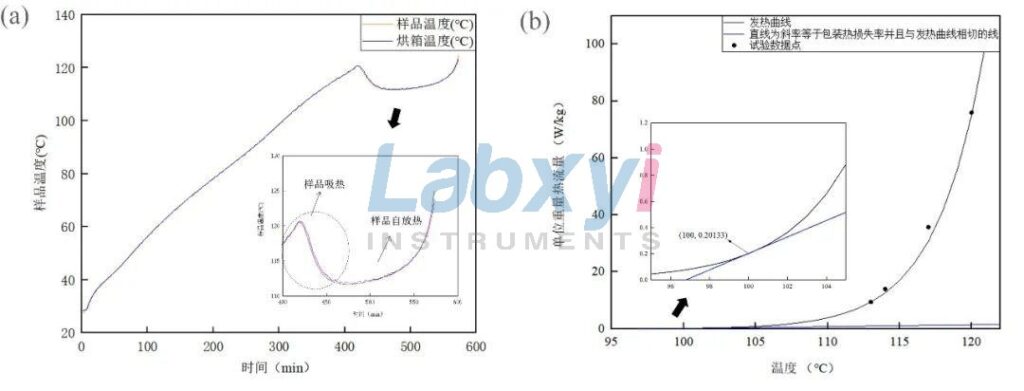Conventional self-accelerating decomposition temperature (SADT) testers mostly use water cooling methods, making it difficult to detect nitro compounds and diazonium compounds with rapid heat generation and high decomposition temperatures. In response to these issues, Xiangyi Instrument has upgraded and optimized the CIT27-10S adiabatic self-accelerating decomposition temperature tester, developing the CIT27-20S adiabatic self-accelerating decomposition temperature tester, which features efficient liquid nitrogen cooling technology. This significantly enhances the instrument’s testing capabilities and safety.
Preface
The Self-Accelerating Decomposition Temperature (SADT) is the highest permissible environmental temperature for reactive chemicals under specific packaging materials and dimensions during actual application. It is also the minimum environmental temperature within which reactive chemicals in actual packaging will undergo self-accelerated decomposition over a period of 7 days. Once the storage environment temperature exceeds SADT, there is a risk of fire or explosion. SADT reflects the thermal hazards of chemicals and is an important parameter for assessing and regulating the safety of chemical storage and transportation.
The explosion of nitration waste at Xiangshui, Jiangsu on March 21, and other major accidents have prompted the state and society to pay increasing attention to the safety of chemical storage and transportation. On August 16,2022, the Department of Hazardous Chemicals Supervision of the Ministry of Emergency Management released the “Draft Interpretation of the ‘Four Zero’ Issues in Fine Chemicals (for Public Comment),” which clearly states: “If the stored chemicals are thermally sensitive, they may release heat upon decomposition and pose a risk of fire or explosion. The SADT of this substance under the current packaging specifications must be assessed with particular emphasis.”
Currently, the detection of chemical SADT primarily relies on the United Nations’ “Recommendations on the Transport of Dangerous Goods-Manual of Tests and Criteria” and the “GB/T 39090 Method for Insulation Storage Testing of Dangerous Goods.” Test instruments developed according to these standards mostly use water as a coolant, with a maximum cooling capacity not exceeding 500W/kg, and are typically only suitable for samples with an SADT below 80℃. Therefore, samples with high initial decomposition temperatures and rapid heating rates can only be estimated using thermal analysis to determine SADT[1]. For example, the estimated SADT for nitromethane is 161℃, and calculations show that if actual measurement is required, the instrument must have a cooling capacity of over 1000W/kg, which current market products cannot meet.
In view of the above problems, Xiangyi Instrument Co., Ltd. has developed a new “CIT27-20S Insulation Self-accelerating Decomposition Temperature Tester”, which is equipped with a new liquid nitrogen refrigeration module and can achieve a maximum cooling capacity of 2000W/kg, which can significantly improve the testing range of the instrument and ensure the safety of the experiment.
In this paper, a new instrument was tested by using a diazo dye intermediate with a fast heat release rate as the sample. The SADT of the sample was measured to be 100℃, and the cooling system still had the cooling capacity when the maximum heat rate was reached. The experimental process was safe and reliable.

Figure 1 Appearance and key components of CIT27-20S instrument:
It is equipped with a self-pressurized liquid nitrogen tank, and the refrigeration mode is changed from U-tube water cooling of CIT27-10S to L-tube liquid nitrogen spray cooling
Test cases
- Test conditions
Experimental instrument: Xiangyi Instrument CIT27-20S adiabatic self-accelerated decomposition temperature tester
Sample: diazo dye intermediate, 120g
Experimental mode: standard
Packaging material type: 1A1
Packaging heat loss: 63mW/kg
Experimental temperature: 120℃
Heating rate: 15℃/h

Figure 2. Picture of the experimental site
- Experimental results
The sample temperature rise curve is shown in Figure 3(a). When the sample reaches the target temperature of 120℃, it first undergoes endothermic expansion. After the expansion is complete, self-heating can be detected, at which point the instrument controls the environmental temperature to track the sample temperature. Once the self-heating rate of the sample reaches the threshold, the cooling device automatically activates. As shown in Figure 3(b), after the experiment, an appropriate temperature point on the adiabatic temperature rise curve is selected to calculate the heat release rate per unit mass at that temperature, and a heating curve is fitted using the least squares method. At the same time, the heat loss rate per unit mass K during actual transportation is determined to be 0.063W/(K·kg). A straight line with a slope of K and tangent to the heating curve is plotted in the graph, with its intercept on the x-axis corresponding to the critical environmental temperature, which is the highest temperature at which no self-accelerated decomposition occurs in the packaged material. The SADT is adjusted upward to the nearest integer multiple of 5(℃), so the SADT for this sample is 100℃.

Figure 3 (a) Sample heating curve and (b) heating curve fitted with SADT
Conclusion
The adiabatic self-accelerating decomposition temperature tester CIT27-20S improves the refrigeration efficiency and can be more widely and safely applied to the SADT test of chemicals. Especially for the storage and transportation of hazardous chemicals such as nitrates and diazotides, it can give reliable and accurate measured data, helping fine chemical enterprises respond to the “four zero” policy and ensure production safety.
